Sulfur-infiltrated porous carbon microspheres with controllable multi-modal pore size distribution for high energy lithium–sulfur batteries†
Abstract
Sulfur has received increasing attention as a cathode material for lithium–sulfur (Li–S) batteries due to its high theoretical specific capacity. However, the commercialization of Li–S batteries is limited by the challenges of poor electrical conductivity of sulfur, dissolution of the polysulfide intermediates into the electrolyte, and volume expansion of sulfur during cycling. Herein, we report the fabrication of novel-structured porous carbon microspheres with a controllable multi-modal pore size distribution, i.e., a combination of interconnected micropores, mesopores and macropores. Cathodes made of sulfur infiltrated in such a hierarchical carbon framework provide several advantages: (1) a continuous and high surface area carbon network for enhanced electrical conductivity and high sulfur loading; (2) macropores and large mesopores bridged by small mesopores to provide good electrolyte accessibility and fast Li ion transport and to accommodate volume expansion of sulfur; and (3) small mesopores and micropores to improve carbon/sulfur interaction and to help trap polysulfides. An initial discharge capacity at 1278 mA h g−1 and capacity retention at 70.7% (904 mA h g−1) after 100 cycles at a high rate (1 C) were achieved. The material fabrication process is relatively simple and easily scalable.


 Please wait while we load your content...
Please wait while we load your content...